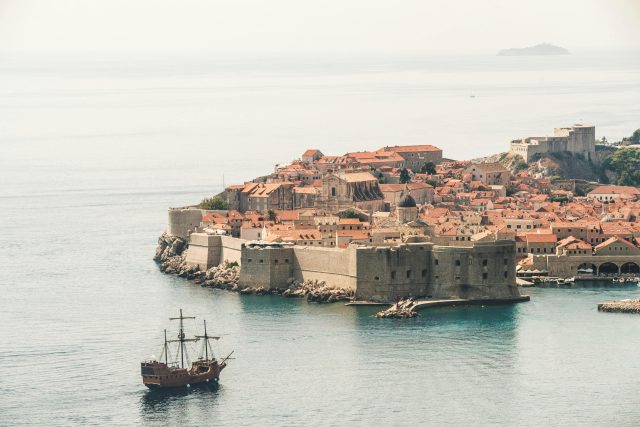
European Diary: Dubrovnik, October 2024
In 1247, the papal envoy Cardinal William of Sabina (sometimes called William of Modena) visited Norway to crown King Haakon IV Haakonsson. He was told that the Icelanders were reluctant to plead allegiance to the Norwegian king, upon which he commented that it was ‘improper that this country did not serve under a king, as did all other countries in the world’. Icelandic historians have often invoked his comment in support of ‘Icelandic exceptionalism’, that Iceland was in the Commonwealth period from 930 to 1262 quite unique in not being a kingdom. But they have not noticed, apparently, how strange this comment was coming from an Italian who had to be familiar with her many city states. Moreover, William of Sabina had been a papal envoy to the Baltic states in 1222 where he had mediated between the Livonian Brothers of the Sword, the Danes and the Russians who had all laid claim to what then was called Livonia and extended over most of Estonia and Latvia. The Livonian Brothers of the Sword ultimately gained control of the region. Thus, William of Sabina knew personally many countries that did not serve under a king.
Liberty Written on the Flag
The Icelandic Commonwealth was therefore not as exceptional as William of Sabina suggested. I was however reminded of his comment when I spent a few days in Dubrovnik in October 2024, speaking at a conference held by the ECR Party, the European Conservatives and Reformists Party. The city of Dubrovnik, then known under the Italian name Ragusa, was founded in the seventh century and initially enjoyed the protection of the East Roman (Byzantine) Empire. It soon became a commercial centre on the Adriatic Sea. In 1205 Dubrovnik became a protectorate of the Republic of Venice, but after a war between Venice and Hungary it became in 1358 an independent republic, consisting of the city, narrow strips of the coast on both sides and some islands. Dubrovnik, or Ragusa, was an independent republic for the next 450 years, although it paid a tribute first to the Hungarian king and then to the Ottoman sultan. In 1808, however, Napoleon abolished the Republic and incorporated it in his Italian kingdom. After Napoleon’s defeat Dubrovnik became part of the Kingdom of Dalmatia under the Habsburgs, subsequently a part of Yugoslavia and in 1991 a part of Croatia.
The political system of Dubrovnik could be described as a relatively liberal oligarchy, modelled partly on the Venetian system. The power was in the hands of about fifty noble families. All male members of those families, eighteen years and older, sat in the Major Council which annually elected the Minor Council with seven members and the Senate with 45 members over forty. It also elected the head of state, the ‘Rector’ (knez), but went to great lengths to avoid any temptation of a Rector to expand or abuse his power. He had to be over fifty, only held office for a month, and could only be reelected after two years. In modern terms, it might be said that the Major Council was the legislature, the Rector and the Minor Council the executive branch of government, and the Senate a consultative body, but with considerable power. Some cases heard by the criminal and civil courts of Dubrovnik could also be appealed to the Minor Council and the Senate. The law was based on the Roman tradition. The flag of the Republic had the word ‘Libertas’ (liberty) on it, and the entrance to a fortress outside the city bore the inscription ‘Non bene pro toto libertas venditur auro’ (Liberty cannot be sold for all the world’s gold).
Two Countries Not Serving under a King
It is interesting to compare the Dubrovnik Republic and the Icelandic Commonwealth. In Iceland, law was based on the Germanic tradition, and the power to revise it and to make and enforce judicial decisions was in the hands of 39 chieftains, usually prosperous farmers, where the chieftainships could not only be inherited, but also bought and sold, and where farmers could choose between the chieftainships in their respective parts of Iceland. The only official of the Commonwealth was the Lawspeaker who could perhaps be regarded as the head of state, as was the Rector of Dubrovnik. The Lawspeaker was elected for three years, and his task was to recite the law at the annual assembly of the chieftains, one third each year, and after the law had been written down in 1119, to interpret and advise on it. Iceland was a poorer and much more primitive country than Dubrovnik, but nevertheless she produced a rich literary heritage, the sagas, chronicles, and Edda poems. The Icelanders also discovered America (in the year 1000) although they had the good sense to lose it again, as Oscar Wilde quipped. Crucially, the Icelanders of the Commonwealth and the Dubrovnikians of the Republic were not subject to the same arbitrary rule as the inhabitants of the countries next to them, Norway and Scotland on the one hand and Hungary and the Ottoman Empire on the other hand.
Dubrovnik is often called the ‘Pearl of the Adriatic’, and it is one of the most beautiful places I have ever visited. The Republic was quite prosperous and progressive for its time. Although the nobility had a monopoly on political power, the economy was relatively free, and open to all, also women and people of colour. The bureaucrats were few in number and mainly employed in keeping records. Trade was lively, and many seafarers and merchants became wealthy. Slavery was abolished in 1416, and ships from the Republic refused after that to carry slaves. Effective laws were passed on bankruptcy and private insurance, and individual property rights were protected. The currency, based on silver, was sound. As Oleh Havrylyshyn and Nora Srzentic argue in their book, Institutions Always ‘Mattered’: Explaining prosperity in Mediaeval Ragusa (Dubrovnik), this remarkable city state enjoyed ‘a favorable business and rule-of-law climate’.



 Subscribe
Subscribe